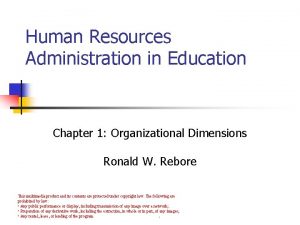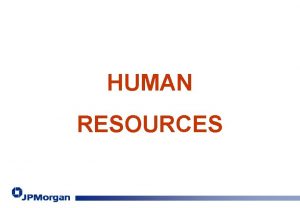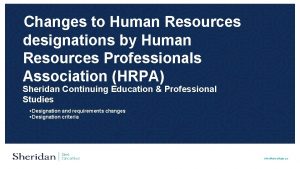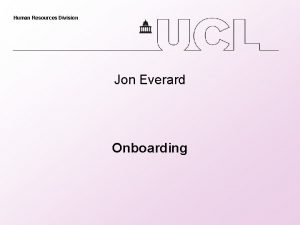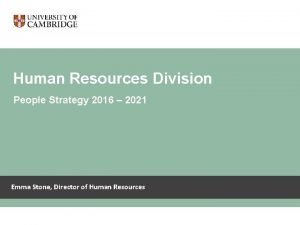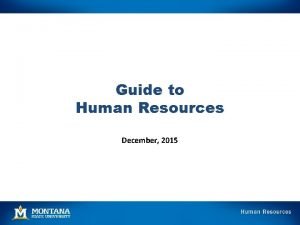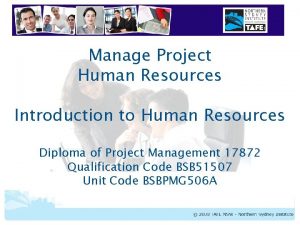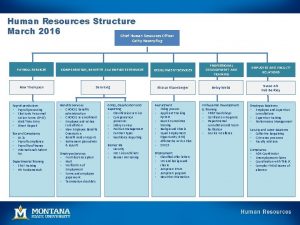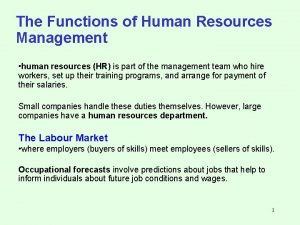EDUCATION SECTOR Human Resources for Quality Education in

















![7. 0 Recommendations Made in that Context A] Shot Term: ==Improve The efficiency in 7. 0 Recommendations Made in that Context A] Shot Term: ==Improve The efficiency in](https://slidetodoc.com/presentation_image_h/067df28d33633ec3bab822def03c882f/image-18.jpg)
![B] Long term strategies Needed 8. 1 A Nation at Risk. The extremely low B] Long term strategies Needed 8. 1 A Nation at Risk. The extremely low](https://slidetodoc.com/presentation_image_h/067df28d33633ec3bab822def03c882f/image-19.jpg)

- Slides: 20

EDUCATION SECTOR Human Resources for Quality Education in Tanzania Issa Omari Heather Baser Dar es Salaam Tanzania 01. 11. 2011

1) The Key Terms of Reference Purpose: Improve our understanding: Do we know what is going on? • Improve the HR in terms of: – Attraction: Are we attracting the best brains? – Availability: Are the HR there to be attracted and recruited ? – Deployment Strategies: Are we Monitoring the production pipeline? Getting them in time? Posting them in time? , Giving assignments in time? – Distribution on equitable basis-location, gender, qualifications, disability!! – – Management, Retention, attrition—How are we Doing here? Factors Affecting Availability, Attraction distribution and management Efficiency, Effectiveness, Quality, Productivity—How are we doing here? Levels Motivations and Job Satisfaction—How high?

2) The Context of the Analysis • • Education and Training Policy 19995 2008 -17 Education and Training Sector Development Programme Policy (2007) 2010 -13 Medium Term Strategic Plan (2009) 10 Development Plans/Programmes, PEDP II, SEDPI, SEDP ll. FEDP, HEDP, STHEDP, TEDMS, TVEDP

Focus = Expansion, Equity, Access, quality, Capacity Building, Relevance, Instructional Arrangements; Cross –cutting Issues [Box 1] • 3. Volume and Numbers Enrolments Teachers • Pre-Primary 1, 068, 208 10, 830 • Primary 8, 419, 305 165, 856 • Secondary 0 -Level 1, 566, 685* 40, 517 • A-Level 72, 014** [shared] • Teacher Ed 25, 814 (13, 679 Dip) 1745 • Hi. ED 139, 638 3083 • Ter-Tech 85, 040 3754

• 4. Participation Rates NER GER • (Tables) • Preprimary 42. 4 N/A • Primary 94. 0 102. 7 • Secondary O Level 35. 5 50. 2 • A Level 2. 0** 5* • Higher Ed ( Age: 20 -23+) 3. 0** 8. 0++ ++ Use of narrow denominator

5) Methods Used Samples: 8 Regions Balanced for High-Medium and Low Performance in Edu – 2 Districts in each Region. Rural Urban – 10 Primary Schools in each District – 10 Secondary Schools in each District [Table 2] – 4 Ministries – MEVT, PO-MPALG, P. O. MD; MF – 5 Public Universities; 5 Private Universities – 6 RVET; 14 TTC (34 public) 11 Private (58); All Support Agencies (10)

6) Instruments for Data Collection • HR Ministry, HR Regions; HR Districts; HR School Working Environment; HR Agencies and Universities • HR Factors Affecting Availability, Distribution and……… • HR Interviews – HR Directors; DEOs, etc 4) Support Institutions → TTE vs NECTA Overlaps on textbooks → TLS ok → HELSB vs TCU vs TEA (duplication in financing & selection) → TCU–NACTE–VETA- competition and compromises in accred. . → TIAE vs Faculties& colleges of Education- degree program → ADEM – ok But need for Higher Level Training

7) Key Results 7. 1. The Key supply side constraints • Who Joins the Teaching Profession? (a) Grade A – 85%Div IV!!26 -28 points (b) Diploma One Principal Pass + Remediation (c) University Cut- Off at 4. 00 GPA VS 10 - BA Pol • Lack of monitoring the supply pipeline—How many taking what? • Wastage between May and March following year-No Hiring!! • Disillusionment: Proliferation of Non Teaching Education Degrees • Poor and Diminishing Support (Participation Rate) of private sector • Poor participation of women in schooling • Poor participation of women in education management • Poor supply of science candidates r performance] <10 % in Divisions I, III: 17. 8 pass in Maths • Very few people taking science Ratio<1: 2

Effectiveness, Quality and Productivity Poor or Average Indices, e. g. , in-service, OPRAS, Budgets, Culture, technology, etc [12 variables Fig 1] 7. 2 Capacities and Capabilities Required HR Equation (Fig 3) ==poor individual, group, or system capability to deliver!!! 7. 3 Budgetary Allocations as Key Constraint (Table P 54) Poor: Total 16. 9%; HE 27. 2 much to loans not edu; SEC 9. 8; TE 1. 6%; 6. 3 GDP; Pri + all others-50. 8; 7. 4 Attitudes towards the Sector as a supply Constraint – Mass Media – Negativity too much!!! – Ministry Attitude – Those who fail will join teaching!!! – 7. 5 Key Efficiency and Effectiveness Measures.

6. 0 Key Systems Inefficiencies and Ineffectiveness A) Efficiency Indicators 6. 1. Extended Absenteeism – With or Without Permission Mbeya, Morogoro, Iringa and Kilimanjaro leads (Table 18) (3593 in 2007) 6. 1. 1 Reasons for Absenteeism (P 3 Table 18. 1) 6. 1. 2 Teachers Teaching below the 24 periods per week 53% at primary and 57% at secondary level in a situation with great shortages of teachers Table 18. 2. 6. 1. 3 High Failure Rates High Repetition Rates 6. 1. 4 Paying for Ghost Workers (Table 21) (2, 800, 000=2007: Money terms) 6. 1. 5 Poor Record in implementing own policies.

7. 0 Key Ineffectiveness Indicators: Not Achieving Goals 7. 1 7. 2 7. 3 7. 4 7. 5 Poor Pass rates (Table 23) Large % of Students Scoring ZERO (Table 25) Oscillation or Indifference in English Language use Shortages of Teachers [61. 5%!!!] (a) Core subjects (Table 29= 48, 485) (b) Optional subjects (Table 30=3, 251) Level of Job Satisfaction → Reasonably Happy Despite ---but watch (a) Bitterly Complain salaries, allowances, and poor salary progression (b) Illegitimate Managers- Acting Capacity: Commissioner - Director sec Director Policy Planning - Chief Inspector - Director Primary - Director VET PLUS (c) Key Desks Occupied by Non Educationists –PS, DHE, DPP, DHRM Net Result - Dialogue not on education - Focus of Actions not coordinated

8. 0 Teachers and Tutors Views on Factors for Attraction 1. 2. 3. 4. 5. 6. 7. Factors for Attraction and Retention – salary, allowances, importance of teachers; Factors for faster deployment –Information and management improvement; Factors for accepting difficult areas – Higher salaries - availability of key services Factors for retention – Higher salaries + School management; Factors for improvement of teaching and learning outcomes - Improve pre-service - Improve in-service Factors for liking teaching - better pay - Better working environment Factors making teachers hate teaching – Poor pay package - Difficult working enrolment - Lack of appreciation

9. 0 HR Issues in support Institutions and Universities 9. 1 Overlaps and redundancy in support institutions = Heavy Overhead money not going to Edu but PE!! (a) For quality assurance and control TCU – NACTE – NECTA - VETA (b) For Education services TIE - NECTA (c) For Training ADEM vs Faculties and Colleges vs IAE (d) For Admission TCU – Universities – HESLB (Indian * Model – Grants commission 586 employees-Does All (e) For financing TEA – Ministry – Donors - Universities

9. 2 Dotted Ph. Ds vs Quality Service vs Motivation (Table 38) What added Value? Any Ratio? Study 9. 3 Universities [Too many universities little education p, 26: Loss of Confidence as the greatest Equalizer) 9. 3. 1 Uneven distribution of Ph. D Level staff (Table 39) 9. 3. 2 Preponderance of Teaching by junior staff (Table 39 b) 9. 3. 3 Too many Tutorial Assistants and Assistant Lecturers 9. 3. 4 Skewed age distribution at UDSM 9. 3. 5 Poor working conditions in universities * Higher Education Budget Not going to Education but students Loans [The Pandora Box Phenomenon].

10. Key Recomendations 1. 0 The Centrality of human resources in the education sector in any country cannot be overemphasized- impact on all schooled people in the country who manage all other sectors. 2. 0 Similarly, the sensitivity of the education sector to the entire society cannot also be under estimated. Almost all families in the country have children in it schools.

3. 0 Not Hopeless situatin –Not broken Yet –intact to villge 4. 0 Challenges rapid changes in the society, with a greatly expanded education system at All Level==explosive demand== 5. 0 Greatly dispersed HR

![7 0 Recommendations Made in that Context A Shot Term Improve The efficiency in 7. 0 Recommendations Made in that Context A] Shot Term: ==Improve The efficiency in](https://slidetodoc.com/presentation_image_h/067df28d33633ec3bab822def03c882f/image-18.jpg)
7. 0 Recommendations Made in that Context A] Shot Term: ==Improve The efficiency in implementing its own policies; == Reduce key officers on acting capacity for far too long; ==Address Mixture of educationists and generalists in management; ==Eliminate Payment of ghost workers; == Reduce absenteeism from class, school, and offices; == Address the Concern: Too many universities but little education!! == Address Overlaps and redundancy in support institutions == Address Shortages of teachers, especially Mt, science, Lang == Streamlining the management of teachers welfare issues == Determine and enforce and working with Norms and standards; == Eliminate the gestation period btn graduation and hiring == Improve the quality of the working environment of teachers.
![B Long term strategies Needed 8 1 A Nation at Risk The extremely low B] Long term strategies Needed 8. 1 A Nation at Risk. The extremely low](https://slidetodoc.com/presentation_image_h/067df28d33633ec3bab822def03c882f/image-19.jpg)
B] Long term strategies Needed 8. 1 A Nation at Risk. The extremely low levels of performance of our schools, especially in mathematics and the sciences is totally unacceptable. We pay heavily for ineffective education system. This will require special attention and strategy. 8. 2 Skewed Distribution of staffing in higher education Too many young inexperienced staff teaching in our universities. Too many people with low level of education, (BA, MA) teaching in our universities. Too few professors teaching in our universities Too few Ph. Ds in our support institutions and diploma colleges

8. 3 Confidence and Competency in English Language. 8. 4 Being present when Investments Decisions are being made. What skills do you need? We have to provide them. ” 8. 5 And many more in the report but Welcome more Thanks all.
 Human resources in education sector
Human resources in education sector Orb education quality teaching resources
Orb education quality teaching resources Human resources administration in education
Human resources administration in education The transformation process in operations management
The transformation process in operations management Fixed resources definition
Fixed resources definition Renewable vs nonrenewable resources worksheet
Renewable vs nonrenewable resources worksheet Multiple nuclei model ap human geography definition
Multiple nuclei model ap human geography definition Cbd models
Cbd models Key reform thrust of besra
Key reform thrust of besra Education sector reforms in pakistan
Education sector reforms in pakistan Perform quality assurance
Perform quality assurance Pmp quality vs grade
Pmp quality vs grade What are quality standards in project management
What are quality standards in project management Ana quality assurance model
Ana quality assurance model Compliance vs quality
Compliance vs quality Basic concepts of quality assurance
Basic concepts of quality assurance Quality gurus of tqm
Quality gurus of tqm Quality is free: the art of making quality certain
Quality is free: the art of making quality certain Old quality vs new quality
Old quality vs new quality Kontinuitetshantering
Kontinuitetshantering Typiska novell drag
Typiska novell drag


